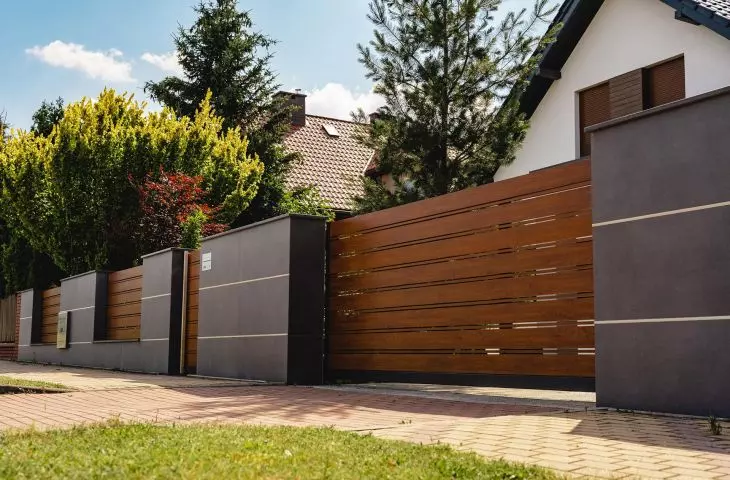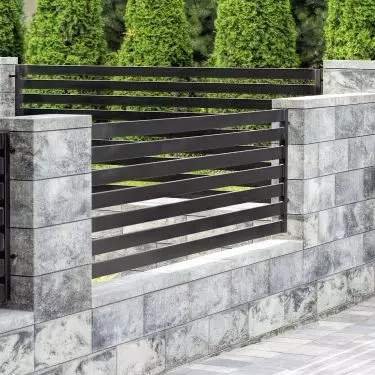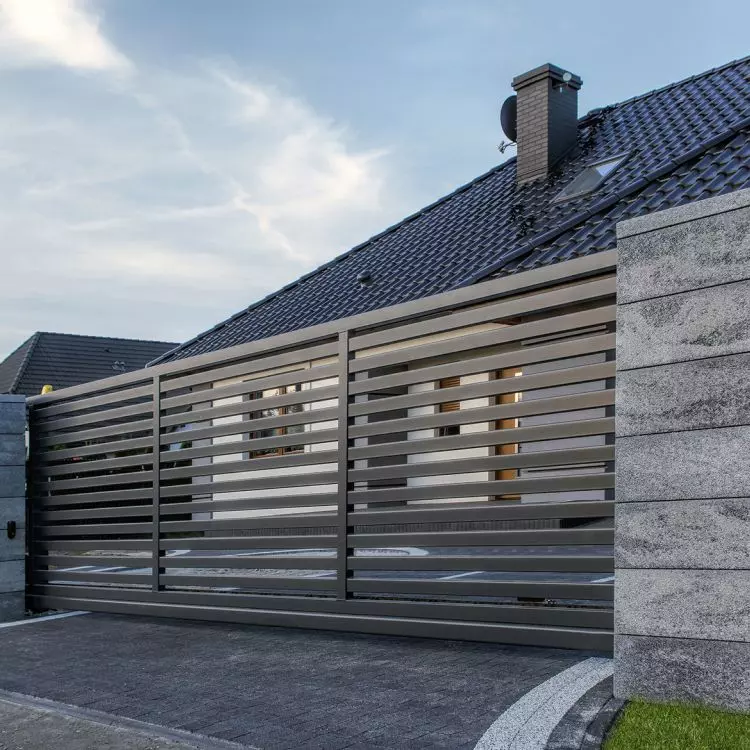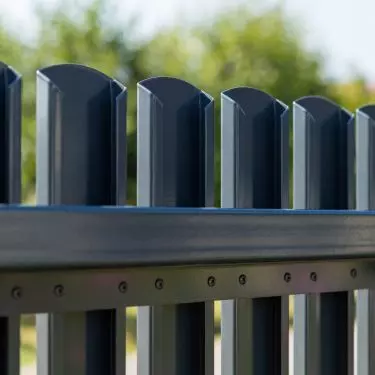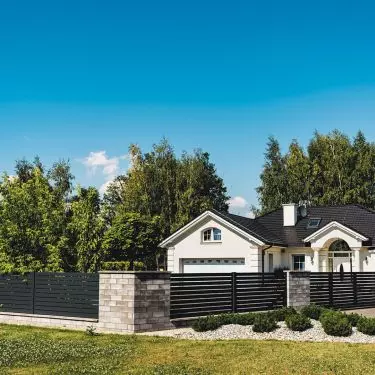Choosing the right fence is one of the most important tasks facing home and property owners. A fence serves many important functions, both practical and aesthetic. It protects our property, provides privacy, and also serves as a showcase for our home. What kind of fence to choose? We suggest!
Choosing a fence in 2023
From which company to choose a good fence?
Choosing the right fence manufacturer is of great importance for the quality and durability of the product and the soundness of the structure. There are many reputable companies on the market that offer high-quality fencing. One of them, for example, is JONIEC, which has been recognized by customers for years for its innovative solutions and solid workmanship. You should also consider the offer of companies such as FELLO, MILORD and WIŚNIOWSKI, which also offer products of very good quality. Before making a decision, it is worth reading the opinions of other customers and consulting a professional and the full list of recommended manufacturers can be found in the search engine of the Products for Home portal under the keyword "fence".
How much does a meter of fencing cost?
A mesh fence costs about PLN 15-30 per meter. Panel fencing costs about PLN 55-80 per meter. PLN 150-1000 per running meter is the price of modular fencing. The foundation for the fence costs from about PLN 60 to 100 per meter.
Concrete fencing is durable and resistant to weather conditions
© JONIEC
Types of fences
Wooden fences
Wooden fences are popular for their natural charm and warm appearance. They can be made of different types of wood, such as oak, pine or cedar. Wood fences are available in a variety of styles, such as plank fences, classic fences or shaped panels.
Metal fences
Metal fences, such as steel or aluminum fences, are durable and weatherproof. They can range in design and style from modern and minimalist to more ornate. Metal fences are also used in the form of mesh or spans.
Mesh fences
Mesh fences are popular for their versatility, air permeability and relatively low price. They can be used to fence off properties, vegetable gardens, courtyards or tennis courts.
Concrete fences
Concrete fences are durable and weatherproof. They can come in a variety of designs and textures, such as clinker, imitation stone or wood. Concrete fences are often used as roadside fences or at commercial properties.
Stone fences
Stone fences, such as stone walls, are popular for their natural appearance and durability. Stone can be used for walls of varying heights and styles, adding a rustic charm to the garden.
Panel fences
Panel fences consist of rectangular panels made of metal, such as steel, aluminum or galvanized stainless steel. The panels are connected to each other by horizontal or vertical posts, creating a unified structure.
Gabion fence
Gabion fencing consists of metal mesh, usually made of galvanized steel, forming gabion baskets. The baskets take the form of rectangular or hexagonal containers that are filled with stones or other natural materials such as slate or gravel.
Hedges
Hedges are natural fences formed by dense growing plants such as boxwood, juniper, or hornbeam. Hedges can provide privacy, aesthetics and ecological value, but require regular pruning and maintenance.
Metal fences with mesh panels
This type of fence consists of metal mesh panels reinforced with steel posts. It is durable, secure and provides good visibility to the outside. It is often used in areas where security is important, such as industrial properties or public facilities.
Concrete fences can come in a variety of designs and textures, such as clinker, imitation stone or wood
© JONIEC
What to look for when choosing a fence?
Determine your goals and needs
Consider what purpose you want the fence to serve. Do you want to provide privacy, protection from intruders, enhance the aesthetics of your garden, or perhaps protect yourself from wind or noise? Determining your priorities will help you choose the right type of fence.
Choose the style and design
The fence should match the style of the house and the surrounding area. Look at different styles of fencing and choose the one that best suits your taste and the character of the property.
Determine your budget
Before starting your search, it's a good idea to determine your budget. The cost of a fence can vary depending on the type of material, its length and the complexity of installation. Finding a balance between quality and price will be key.
Check local laws and regulations
Before buying a fence, check local laws or regulations that may restrict the type, height or appearance of the fence. Make sure your choice complies with regulations to avoid potential legal problems in the future.
Pay attention to durability and maintenance
Some fencing materials, such as wood, may require regular maintenance. Consider how much time and effort you are willing to devote to fence maintenance. If you prefer a less demanding solution, pay attention to materials that are weather-resistant and do not require frequent maintenance.
Consult a professional
If you're not sure what kind of fence will be best for your property, it's a good idea to consult a professional, such as a landscape architect or fence specialist. This person can assess your needs, advise on the right type of fence and help you install it.
If you're not sure what kind of fence to choose, consult a professional
© MILORD
How to determine the distance between fence posts?
The distance between posts depends on several factors, such as the type of fence, the material of the posts, the height of the fence and local regulations. Here are some general guidelines for the distance between posts:
Panel fences
If you are using a panel fence, place the posts every 2-3 meters. However, it is worth checking the manufacturer's instructions, as the distance may vary depending on the type of panels and their dimensions.
Mesh fences
For mesh fences, the distance between posts depends on the height of the fence and the type of mesh. In general, for fences 1.2-1.8 meters high, posts are placed every 2-3 meters. For taller fences, it may be necessary to place posts more frequently, every 1.5 meters or so.
Wooden fences
The distance between posts for wooden fences can depend on the type of wood, its thickness and the height of the fence. Typically, posts are placed every 1.8-2.4 meters. It is also important to adjust the distance in order to ensure adequate rigidity and stability of the fence.
Gabion fences
For gabion fences, the distance between posts depends on the size and weight of the gabion baskets. Typically, posts are placed every 1.5-2 meters. It is important to ensure that there are enough posts to make the fence stable and secure.
How to mark out the fence?
Determining the line for a fence requires proper measurement and marking of the route where the fence will be installed. Here are some steps that can help you determine the line for the fence:
Determine the boundaries
Decide exactly where you want the fence to go. Imagine how you want the fence to surround your property and mark the boundaries to be fenced. This can be the plot's boundary line, a path or another reference point.
Measure the space
Use a tape or measuring laser to measure the length of the sections where the fence will be located. Check that the length of the sections is consistent with the planned placement of the fence posts.
Mark the points of the posts
Based on the measurements, mark the points where the fence posts will be placed. You can use special pegs or spray to mark the area.
Check the level
Before you start installing the fence, check the level of the land. Use a level to make sure the fence line will be level and there will be no slope up or down.
Mark out the path of the fence
Once you've marked the points of the posts, connect them using a line, such as string, to mark out an exact fence path. Make sure the line is straight and in line with the marked post points.
Check local regulations
Familiarize yourself with local laws and regulations for fence installation to make sure you follow all requirements for fence height, materials or location.
The distance between posts depends on several factors, such as the type of fence, the material of the posts, the height of the fence and local regulations
© FELLO
What to use under the fence mesh?
Stones or gravel
Placing a layer of stones or gravel under the fence netting can help prevent weed growth and keep the area around the fence clean. Stones or gravel can also provide an aesthetically pleasing appearance.
Lawn band
Placing a band of lawn under the fence mesh can help keep it along the fence. A lawn band will prevent the spread of weeds and allow for easy mowing and lawn care.
Geotextile fabric
Geotextile fabric is a special material that can be placed under the fence mesh to inhibit the growth of weeds. This fabric allows water and air to pass through, while preventing the growth of unwanted plants.
We encourage you to take advantage of the database of reputable and reliable Fencing Manufacturers we are building in the Products For Home portal, as well as the artciles we publish on the fences available on the market adapted to changing trends and legal requirements.
Elaboration:KATARZYNA SZOSTAK



